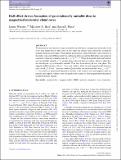Hall effect-driven formation of gravitationally unstable discs in magnetized molecular cloud cores
Abstract
We demonstrate the formation of gravitationally unstable discs in magnetized molecular cloud cores with initial mass-to-flux ratios of five times the critical value, effectively solving the magnetic braking catastrophe. We model the gravitational collapse through to the formation of the stellar core, using Ohmic resistivity, ambipolar diffusion and the Hall effect, and using the canonical cosmic ray ionization rate of ζcr = 10−17 s−1. When the magnetic field and rotation axis are initially aligned, a ≲ 1 au disc forms after the first core phase, whereas when they are anti-aligned, a gravitationally unstable 25 au disc forms during the first core phase. The aligned model launches a 3 km s−1 first core outflow, while the anti-aligned model launches only a weak ≲ 0.3 km s−1 first core outflow. Qualitatively, we find that models with ζcr = 10−17 s−1 are similar to purely hydrodynamical models if the rotation axis and magnetic field are initially anti-aligned, whereas they are qualitatively similar to ideal magnetohydrodynamical models if initially aligned.
Citation
Wurster , J , Bate , M R & Price , D J 2018 , ' Hall effect-driven formation of gravitationally unstable discs in magnetized molecular cloud cores ' , Monthly Notices of the Royal Astronomical Society , vol. 480 , no. 4 , pp. 4434-4442 . https://doi.org/10.1093/mnras/sty2212
Publication
Monthly Notices of the Royal Astronomical Society
Status
Peer reviewed
ISSN
0035-8711Type
Journal article
Collections
Items in the St Andrews Research Repository are protected by copyright, with all rights reserved, unless otherwise indicated.

